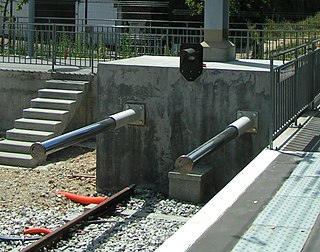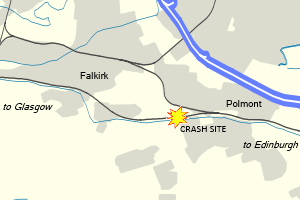
A railroad switch (AE), turnout, or [set of] points (BE) is a mechanical installation enabling railway trains to be guided from one track to another, such as at a railway junction or where a spur or siding branches off.

Brake van and guard's van are terms used mainly in the UK, Australia and India for a railway vehicle equipped with a hand brake which can be applied by the guard. The equivalent North American term is caboose, but a British brake van and a caboose are very different in appearance, because the former usually has only four wheels, while the latter usually has bogies. German railways employed Brakeman's cabins combined into other cars.

There have been four railway accidents at Potters Bar (England). Those in 1898 and 1946 were signals passed at danger. The accident in 2002 led to substantial public debate and a national change in policy relating to maintenance of infrastructure.
The Train Protection & Warning System (TPWS) is a train protection system used throughout the two UK passenger main-line railway networks, and in Victoria, Australia.

A derailment occurs when a vehicle such as a train runs off its rails. Although many derailments are minor, all result in temporary disruption of the proper operation of the railway system and they are potentially seriously hazardous to human health and safety. Usually, the derailment of a train can be caused by a collision with another object, an operational error, the mechanical failure of tracks, such as broken rails, or the mechanical failure of the wheels. In emergency situations, deliberate derailment with derails or catch points is sometimes used to prevent a more serious accident.

A buffer stop, bumper, bumping post, bumper block or stopblock (US), is a device to prevent railway vehicles from going past the end of a physical section of track.

The Polmont rail accident, also known as the Polmont rail disaster, occurred on 30 July 1984 to the west of Polmont, near Falkirk in Scotland, when a westbound push-pull express train travelling from Edinburgh to Glasgow struck a cow which had gained access to the track through a damaged fence from a field near Polmont railway station. The collision caused all six carriages and the locomotive of the train to derail, killing 13 people and injuring 61 others. The accident led to a debate about the safety of push-pull trains on British Rail.

An axle counter is a device on a railway that detects the passing of a train between two points on a track. A counting head is installed at each end of the section, and as each train axle passes the counting head at the start of the section, a counter increments. A detection point comprises two independent sensors, so the device can detect the direction and speed of a train by the order and time in which the sensors are passed. As the train passes a similar counting head at the end of the section, the system compares count at the end of the section with that recorded at the beginning. If the two counts are the same, the section is presumed to be clear for a second train.
Classification of railway accidents, both in terms of cause and effect, is a valuable aid in studying rail accidents to help to prevent similar ones occurring in the future. Systematic investigation for over 150 years has led to the railways' excellent safety record.

The Thirsk rail crash occurred on 31 July 1967 at Thirsk, Yorkshire, England on the British Rail East Coast Main Line.

A derail or derailer is a device used to prevent fouling of a rail track by unauthorized movements of trains or unattended rolling stock. The device works by derailing the equipment as it rolls over or through it.
There have been a number of train accidents on the railway network of Victoria, Australia. Some of these are listed below: Friday 13th September 1974
The railways of New South Wales, Australia have had many incidents and accidents since their formation in 1831..
The Marden rail crash occurred on 4 January 1969 near Marden, Kent, United Kingdom, when a passenger train ran into the rear of a parcels train, having passed two signals at danger. Four people were killed and 11 were injured. One person was awarded the British Empire Medal for his part in the aftermath of the collision.
A Depot Personnel Protection System, commonly referred to as Depot Protection System or DPS, is a system designed to protect staff and equipment by ensuring the safe and controlled movement of rail vehicles into and out of train maintenance depot, a process sometimes known as shunting. This allows train maintenance operations to be conducted without endangering the safety of staff, and damaging other maintenance equipment in the depot.

British Railways inherited a variety of brake vans from each of the Big Four: GWR, LNER, Southern Railway and LMS due to the nationalisation of the railways in 1948.
















